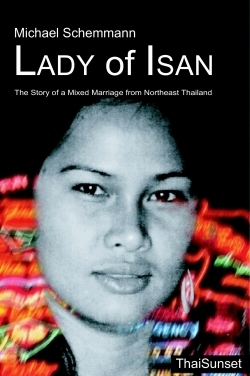
Lady of Isan
The Story of a Mixed Marriage from Northeast Thailand
“There was something about Thailand: It sucked me in,” Michael Schemmann writes of his love affair with the country and, later, a woman. Schemmann once spent a blissful ten days in Chiang Mai during a stopover from Tokyo to Frankfurt. After two failed marriages, the German-born Canadian returned to Thailand in 2001 to teach business classes at Assumption University of Thailand in Bangkok and was quickly persuaded by a colleague to visit sex bars. There, Schemmann, in his fifties, was immediately attracted to Iuu, a nineteen-year-old newcomer from Isan, and fell in love. After a night of passion, she left. He searched for her until he met her family in Isan in northeast Thailand and married her within days.
Age was not the only barrier in their relationship. The young bride was poorly educated, while he had a Ph.D. Like other Isan young women, Iuu desired to meet and marry a farang (foreigner) who would support her and her family. Schemmann frequently confesses that he did not fully understand Thai customs—at least the importance of certain ones—and he failed to show his young bride enough affection. He underestimated the need for Iuu to provide for her mother, for example, when Iuu wanted her mother to live with them, though he had no problem doling out money for her parents and acting as an ATM machine for his wife.
He misjudged Iuu’s independence and ties to her cultural past as she matured and became better educated. He writes, “I took her for granted while she had higher aspirations. We needed shock treatment and received it.”
Their three-year-marriage abruptly fell apart during a quarrel, and Schmemman relates his subsequent obsessive search for her in the cities, sex bars, and countryside. At times the book is oddly addressed to Iuu as Schemmann explains himself and confesses his failures in case she should she ever read it. “It takes time to learn the Thai ways, in particular the Isan ways, and, although a professor, I was a slow learner,” he admits.
Schemmann is a CPA and a prolific writer about finance and Thailand. This book, the third edition of Lady of Isan, would benefit from editing. Punctuation is sloppy; standard capitalization at the beginning of quoted sentences is sometimes missing; numbers and numerals are inconsistently expressed, as are spellings (barber shop, barbershop). The copyright page is troubling with its invented cataloging-in-publication data.
This very personal book, nonetheless, is a curious glimpse into a farang’s mind in a land that few Westerners are familiar with. Schemmann’s quest to locate Iuu leads to new understanding on his part. “So, why was all this heartache necessary?” he asks. “It wasn’t, but it happened. This was Thailand. Farangs are ill-prepared for this sweet, seductive and at the same time brutal world, and I was simply one of them, but not anymore.”
Lady of Isan could serve as a guide to other farangs who are similarly attracted to young women, but who need to understand Thai culture and the potential downfalls of such relationships.
Reviewed by
Linda Salisbury
Disclosure: This article is not an endorsement, but a review. The publisher of this book provided free copies of the book and paid a small fee to have their book reviewed by a professional reviewer. Foreword Reviews and Clarion Reviews make no guarantee that the publisher will receive a positive review. Foreword Magazine, Inc. is disclosing this in accordance with the Federal Trade Commission’s 16 CFR, Part 255.
